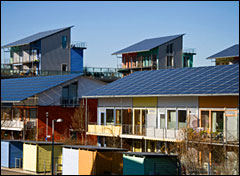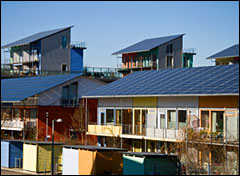 Get a load of this:
Get a load of this:
Nearly 100 million Americans could install over 60,000 megawatts of solar at less than grid prices – without subsidies – by 2021.
That’s from a new report by John Farrell at the Institute for Local Self-Reliance called “Rooftop Revolution: Changing Everything with Cost-Effective Local Solar.”
It’s about the spread of “solar grid parity” over the next 10 years, where grid parity is defined as “when the cost of solar electricity — without subsidies — is equal to or lower than the residential retail electricity rate.” People often talk about grid parity as if it’s some magic moment, but in fact it will happen in different places at different times, depending on local conditions and electricity prices. And it’s a moving target: It depends on how fast the cost of solar falls and how fast electricity rates rise.
Farrell says that the “installed cost of solar has fallen 10% per year since 2006 and grid electricity prices have averaged a 2% annual increase in the last decade.” In his projections, he uses 7 percent annual decline for solar costs and 2 percent for electricity increases, which seems conservative but reasonable. Obviously either of those rates could change, but almost everything I’ve read and heard predicts rising electricity rates; the rate of solar cost decline is somewhat harder to predict. As a technophile, my money is on the cost of solar falling faster than expected.
Anyway, given those assumptions, here’s a map that shows how and when solar grid parity will spread.
By 2021, some 100 million people in the top 40 U.S. metropolitan areas will be at grid parity for residential rooftop solar. The number is larger if you take into account people living outside those areas. It expands again if you assume widespread time-of-use pricing. And of course it expands a whole lot more if you include non-residential (commercial and industrial) rooftops. Like so:

Two big things to note about this:
1. Obviously this doesn’t mean 100 million people will have solar on their roofs in 2021. That’s just the cost-effective potential. To exploit that potential will require smart changes in policy. Farrell mentions several state laws and regulations — lower permitting fees, net metering, the like — but I want to emphasize his recommendations on subsidies.
Right now, there’s a federal solar tax credit of 30 percent that is set to expire in 2016. Tax credits are pretty crappy policy. They exclude the public sector and raise transaction costs to the point that tax credits are twice as expensive as cash grants. Keeping the solar tax credit perpetually in place would mostly enrich big solar developers … but dropping it abruptly would hurt the solar market.
The best option is to phase out the tax credit over time in favor of a less expensive policy responsible for 75 percent of the world’s solar PV and 45 percent of its wind power: feed-in tariffs. Feed-in tariffs — which apparently we’re now supposed to call CLEAN contracts (for Clean Local Energy Accessible Now) — pay people for creating clean energy and feeding it into the grid. If done right, CLEAN contracts could replace America’s entire tangled web of tax rebates, incentives, state mandates, and utility programs with something far simpler, more transparent, and more predictable. CLEAN money could phase out over time as costs drop, as is now happening in Germany.
We could exploit the full potential of solar, but that would require [gasp] planning, and planning is socialist, so oh well.
2. If 100 million people had residential rooftop solar, they’d still only be producing roughly 2 percent of the electricity consumed in the U.S. But electricity generation isn’t the only story here. That’s almost a third of the U.S. population!
That means a whole lot of voters — voters in Florida, Texas, Colorado, Arizona, Nevada — with direct experience being energy producers as well as consumers. They will come to understand the value of local, distributed energy in a tangible way and serve as a political force for its expansion. That’s what has happened in Germany. Smart energy policy doesn’t just create energy; it creates a constituency.
It can also be argued that locally owned solar has greater economic benefits (more jobs, spread more widely, and more money circulating in local economies) and greater benefits to the grid (avoided transmission, peak shaving) than absentee-owned power plants.
Energy policy is not just about numbers. It’s not even just about energy. It cannot be separated from economic development or social change. Energy democracy — local ownership, local benefits, local autonomy — ought to be an explicit goal of policy. In part that means planning ahead to take full advantage of solar’s extraordinary potential.



